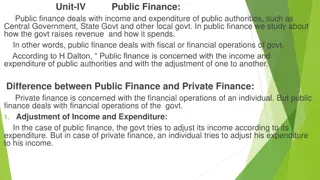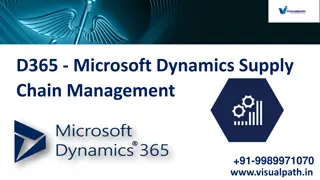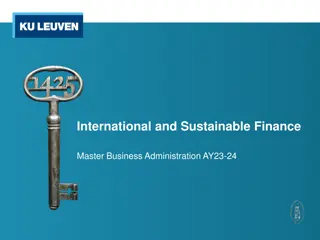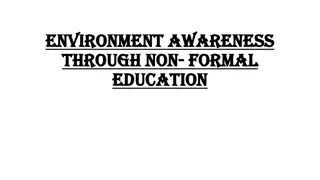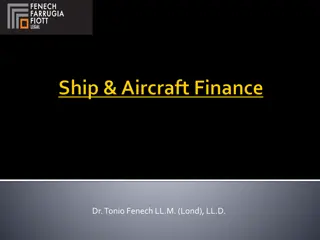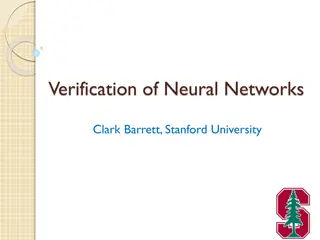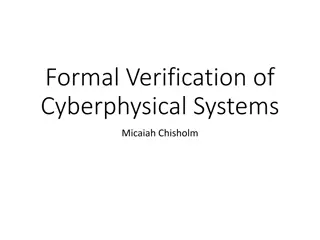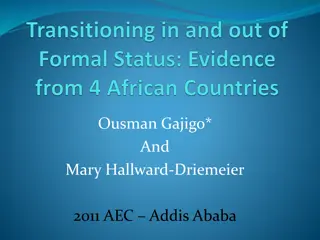
Strengthening Financial Management for Civil Society Organizations Workshop
Explore the Basic Accounting System module, learn about double-entry accounting, financial statement preparation, and compliance with accounting standards. Dive into Fixed Assets, Depreciation, Revenue, Receivables, and more for efficient finance operations in NPOs.
Download Presentation

Please find below an Image/Link to download the presentation.
The content on the website is provided AS IS for your information and personal use only. It may not be sold, licensed, or shared on other websites without obtaining consent from the author. If you encounter any issues during the download, it is possible that the publisher has removed the file from their server.
You are allowed to download the files provided on this website for personal or commercial use, subject to the condition that they are used lawfully. All files are the property of their respective owners.
The content on the website is provided AS IS for your information and personal use only. It may not be sold, licensed, or shared on other websites without obtaining consent from the author.
E N D
Presentation Transcript
Workshop on Strengthening Financial Management of Civil Society Organizations August 25 August 25 September 27, 2021 September 27, 2021 27 27 L Lesson esson H Hours in 17 Days ours in 17 Days (Through Virtual Meeting (Through Virtual Meeting Zoom Technology) Zoom Technology)
Module 3: Basic Accounting System About This Module About This Module The basic accounting system module of this workshop is designed, you to learn about how to set up and operate a double entry accounting system for record keeping and producing reliable financial statements, followed by Sri Lanka Statement of Recommended Practice for Not-for-Profit Organizations or/and the requirements stipulated by the Sri Lanka Accounting Standards (SLFRS Framework) to prepare and present their financial statements. The tools and guidance introduced through this module can help you to set up, revise or realign your existing accounting system in terms of the stipulated standards mentioned here.
Module 3: Basic Accounting System Lesson 4: Lesson 4: Accounting essentials to set up and operate a Double Entry Accounting System September 6 September 6 Lesson 5: Lesson 5: Processing a Formal Accounting System for Efficient Accounting and Finance Operations September 7 September 7 Lesson 6: Lesson 6: Financial Recording and Closing Procedures and functional Competencies in Finance Management relevant to NPOs September 8 Lesson 7: Lesson 7: Special guideline issued to NPOs to prepare and present their financial statements (SLFRS Framework) September 9 September 8 September 9
Financial and Accounting Operations of a CSO Lesson 5 Fixed Assets and Depreciation Intangible Assets Revenue and Receivables Cash Processing Payable Processing and Accrual Inventory Accounting Debt Accounting Payroll Activities Bank Transactions Financial Recording and Closing Procedures
FIXED ASSETS FIXED ASSETS General Underlying Assumptions General Underlying Assumptions All assets shall be managed in accordance with SLAS in compliance with IAS2, IAS16, and IAS38. An asset shall be recognized by Sampled CSO as a Fixed Asset when: a) a) Sampled CSO has physical control of the asset and expects the asset to provide future economic benefits; b) b) The cost of the asset (including the transfer risk and reward) can be measured; c) c) The cost of the asset is above the threshold mentioned in the Capitalization Policy described below.
FIXED FIXED ASSETS ASSETS Capitalization Policy Capitalization Policy All expenditures for individual capital assets of at least Rs. xxxx in value shall be capitalized and depreciated/ amortized using the Estimated Useful Life if: a) the asset is expected to be used for a period of more than 12 months; and b) the asset is used or controlled by Sampled CSO (at main offices, at a regional office, or at a Project site). Any asset with a value less than Rs.xxxx shall be expensed directly.
FIXED FIXED ASSETS ASSETS Capitalization Capitalization Policy All items of Property, Plant and Equipment that meet the recognition criteria shall be recorded in the Fixed Assets Register. At a minimum, the following details shall be recorded: a) date of purchase, cost and description of asset; b) asset class, useful life, depreciation rate and method; c) warranty and serial number; and d) location of asset and custodian name. Policy
FIXED FIXED ASSETS ASSETS Recording Recording Assets acquired in all locations shall be booked in enterprise resource planning (ERP) system (or Accounting Information Systems AIS, like QuickBooks accounting or SAP accounting system) within the same calendar month of acquisition. The initial recognition of the asset shall be at cost. The cost of a fixed asset item comprises its purchase price, including import duties and non- refundable purchase taxes, and any directly attributable costs of bringing the asset to working condition. The total cost shall not include any trade discounts, rebates and other refundable costs.
FIXED FIXED ASSETS ASSETS Recording Recording For assets that have been acquired at no cost (gift, donations, etc.), the cost of the item shall be its Fair Value at the date on which it was acquired. Fair Value shall be determined by either the market value of comparable assets or by an independent evaluator. For assets acquired in exchange of a dissimilar item, the cost of the acquired item shall be measured at the Fair Value of the asset received, which is equivalent to the Fair Value of the asset given up, adjusted by the amount of any cash or cash equivalents transferred.
FIXED FIXED ASSETS ASSETS Recording Recording For assets acquired in exchange of a similar asset that has similar use in the same line of business and which has a similar Fair Value, no gain or loss shall be recognized. Subsequent expenditure on the fixed asset shall only be recognized as an asset when the expenditure improves the condition of the asset, measured over its total life, beyond its most recently assessed standard of performance. However, expenditures related to the maintenance of the asset to restore or maintain the future economic benefits, shall be recognized as an expense when incurred.
FIXED FIXED ASSETS ASSETS Class of Asset and Depreciation Class of Asset and Depreciation Sampled CSO shall use straight line depreciation method. Depreciation shall be charged on an annual basis. For assets acquired in the middle of the year, a pro-rated depreciation shall be charged for that year. Depreciation expenses commence as per monthly convention where the asset is depreciated from the month it is acquired and put to use. There are no residual values for any fixed assets following full depreciation.
FIXED FIXED ASSETS ASSETS Class of Asset and Class of Asset and Depreciation The Estimated Useful Life for each asset class and sub-class is shown in the table below: Depreciation Asset class Land Office Equipment IT Equipment Furniture and Fixtures Vehicle Office Improvement Depreciation method Not Applicable Straight line Straight line Straight line Straight line Straight line Estimated Useful Life in Months No Depreciation 60 36 60 60 24
FIXED FIXED ASSETS ASSETS Funding Categories for Assets Funding Categories for Assets Sampled CSO s assets can be acquired through use of core funds and/or earmarked funds, each as defined in Regulation 4.2. Where assets are acquired through: a a. . Core funds, the assets shall be capitalized and the depreciation will be charged as corporate shared cost in a dedicated Project code. b b. . Earmarked funds, the assets shall be capitalized and depreciation will be charged to the earmarked Project. Upon termination or closure of Project, the residual value of the asset shall be fully charged to the Project.
Regulation 4.2 Type of Contributions Contributions to Sampled CSO are made by Members or by non-Members shall consist of: (i) Earmarked funds. Earmarked funds are funds provided to finance specific programs, projects or activities as agreed by the donor(s) and Sampled CS. Earmarked funds can only be used for the purposes for which they are intended as per the agreement(s) between the donor(s) and Sampled CSO. Earmarked funds shall be kept separate and apart from core funds of Sampled CSO in accordance with Regulation 6.3; and (ii) Core funds. Core funds comprise all core contributions made by contributing Members and all other funds contributed to Sampled CSO that are not earmarked funds. Core funds are available for general use by Sampled CSO and shall be credited to the General Fund in accordance with Regulation 6.1.
Regulation 6.1 General Fund a) A General Fund shall be established for the purpose of accounting for Sampled CSO s administrative costs and its core activities and for reimbursements to the Working Capital Fund. b) All core funds whether current or arrears from Contributing Members and all contributions of Members or non-Members not specified to be earmarked funds under Regulation 4.2(i), miscellaneous income and transfers made from the Working Capital Fund shall be credited to the General Fund. c) All expenditures for core activities shall be made from the General Fund. d) All reimbursements to the Working Capital Fund shall be made from the General Fund.
Regulation 6.2 Working Capital Fund a) A Working Capital Fund shall be established to ensure continuity of operations by: (i) advancing moneys to the General Fund to finance budgetary expenditures pending receipt of contributions; and (ii) advancing moneys to the General Fund to finance unforeseen expenditures not provided for in the current budget. The amount of the Working Capital Fund shall be proposed by the Executive Director and determined by the Council from time to time. b) Advances from the Working Capital Fund to finance budgetary expenditures shall be made only with the written approval of the Executive Director. c) Withdrawals from the Working Capital Fund to finance unforeseen expenditures shall be made only with the written approval of the Executive Director and shall be reported to the Management and Program Sub-committee at its next session. d) Advances made from the Working Capital Fund shall be reimbursed to the Working Capital Fund as soon as possible and, in any case, not later than the next financial period, by program adjustments if necessary. e) Income derived from investment of the Working Capital Fund shall be credited to miscellaneous income and shall accrue to the General Fund.
FIXED FIXED ASSETS ASSETS Physical Count Physical Count Physical count of all assets shall be carried out every six (6) months under the supervision of the Finance Unit for the main office. This shall be approved as per the Delegation of Authority. All differences between the physical status and General Ledger status shall be investigated by Finance Unit. Any adjustments/ write-offs shall be approved as per the Delegation of Authority.
FIXED FIXED ASSETS ASSETS Physical Physical Count For losses amounting to less than Rs xxxx, which may occur at any time during the year or during the physical count shall be written off with documented justification, after relevant approvals as per the Delegation of Authority. A summary statement of losses of non-expendable property shall be provided at the request of the External Auditor within three months following the end of the financial period. Count
FIXED FIXED ASSETS ASSETS Revaluation Revaluation Revaluation of a fixed asset shall be carried out when there is a material change in the market price of an asset. After revaluation, the asset shall be carried at its Fair Value, less any accumulated depreciation. If an item of a particular asset class is revalued, then the entire class of the asset shall be considered for revaluation.
FIXED FIXED ASSETS ASSETS Revaluation Revaluation If the revaluation results in increased value of carrying amount, then the increase shall be credited to revaluation surplus. However, the increase shall be recognized as revenue only to the extent it reverses a revaluation decrease of the same class of assets previously recognized as an expense, and as per SLAS guidance. Assessment of a requirement of revaluation of assets shall be carried out at least yearly.
FIXED FIXED ASSETS ASSETS Impairment Impairment Assets shall be tested for impairment annually at each reporting date. An Impairment loss shall be recognized when the recoverable amount of the asset falls below its carrying amount or book value. The impairment loss shall be expensed in the Financial Statements as per SLAS guidance.
SLAS 18 And IAS 16 : Property, Plant & Equipment Impairment The carrying amount of an item or a group if identical items of property, plant and equipment should be reviewed periodically in order to assess whether the recoverable amount has declined below the carrying mount. When such a decline has occurred, the carrying amount should be reduced to the recoverable amount. The amount of the reduction should be recognized as an expense immediately, unless it reverses a previous revaluation in which case it should be charged to the relevant accumulated fund Revaluation After recognition as an asset, an item of property, plant and equipment whose fair value can be measured reliably shall be carried at a revalued amount, being its fair value at the date of the revaluation less any subsequent accumulated depreciation. Revaluations shall be made with sufficient regularity to ensure that the carrying amount does not differ materially from that which would be determined using fair value at the balance sheet date .
FIXED FIXED ASSETS ASSETS Retirement and Disposal Retirement and Disposal A fixed asset shall be eliminated from the Financial Statements when: a a. . it is obsolete, outdated, broken, lost or cause excessive maintenance or repair costs; b. b. it does not have future use for Sampled CSO (for example, due to closure of office and impracticability of transfer to another office); c. c. it does not have future economic benefit; d. d. it is sold to a third party; or e e. The donor requests Sampled CSO to return the asset upon completion or closure of an earmarked Project in accordance with the provisions of the related agreement. Gains or losses arising from the retirement or disposal of an item of the fixed asset shall be determined as the difference between the estimated net disposal proceeds and the carrying amount of the asset, within the financial period.
INTANGIBLE ASSETS INTANGIBLE ASSETS General Underlying Assumptions General Underlying Assumptions An asset shall be recognized by Sampled CSO as an intangible asset when: a) The asset is identifiable, as follows: - it is separable, that is, is capable of being separated or divided from Sampled CSO and sold, transferred, licensed, rented, or exchanged, either individually or together with a related contract, identifiable asset or liability, regardless of whether Sampled CSO intends to do so; or - It arises from binding arrangements (including rights from contracts or other legal rights), regardless of whether those rights are transferable or separable from Sampled CSO or from other rights and obligations; and
INTANGIBLE INTANGIBLE ASSETS ASSETS General Underlying General Underlying Assumptions An asset shall be recognized by Sampled CSO as an intangible asset when: b) It meets the following recognition criteria: - it is more probable than not that the expected future economic benefits or service potential that are attributable to the asset will flow to the Organization; or Assumptions - the cost or Fair Value of the intangible asset can be measured reliably and it satisfies capitalization threshold requirement of Rsxxxx for new additions and Rsxxxx for internally developed intangible assets.
INTANGIBLE INTANGIBLE ASSETS ASSETS General Underlying Assumptions General Underlying Assumptions Sampled CSO shall assess the probability of expected future economic benefits or service potential using reasonable and supportable assumptions that represent the best estimate of the set of economic conditions that will exist over the useful life of the asset.
INTANGIBLE INTANGIBLE ASSETS ASSETS Recognition Recognition The initial recognition of the asset shall be at cost or Fair Value (if obtained from a non-exchange transaction). Internally generated goodwill shall not be recognized as an asset. For internally generated intangible asset, no intangible asset arising from research (or from the research phase of an internal project) shall be recognized. Expenditure on research (or on the research phase of an internal project) shall be recognized as an expense when it is incurred.
INTANGIBLE INTANGIBLE ASSETS ASSETS Recognition Recognition An intangible asset arising from development (or from the development phase of an internal project) shall be recognized if, and only if, (CSO s Name) can demonstrate all of the following: a a) ) The technical feasibility of completing the intangible asset so that it will be available for use; b) b) Its intention to complete the intangible asset and use it; c) c) Its ability to use the intangible asset; d) d) How the intangible asset will generate probable future economic benefits or service potential; e) e) The availability of adequate technical, financial and other resources to complete the development and to use or sell the intangible asset; and f) f) Its ability to measure reliably the expenditure attributable to the intangible asset during its development.
INTANGIBLE INTANGIBLE ASSETS ASSETS Recognition Recognition Internally generated brands, mastheads, publishing titles, lists of users of a service, and items similar in substance shall not be recognized as intangible assets. Expenditure on an intangible item that was initially recognized as an expense shall not be recognized as part of the cost of an intangible asset at a later date. After initial recognition, an intangible asset shall be carried at its cost less any accumulated amortization and any accumulated impairment losses. Sampled CSO shall assess the length of the Estimated Useful Life of the asset, which shall also be reviewed at each reporting period.
INTANGIBLE INTANGIBLE ASSETS ASSETS Amortization Amortization Sampled CSO shall use straight line amortization method. Amortization shall be charged on an annual basis. For intangible assets acquired in the middle of the year, pro-rated depreciation shall be charged for that year. Amortization expenses commence as per monthly convention where the intangible asset is amortized from the month it is acquired and put to use or the acquisition is reported to the Finance Unit. All intangibles shall have a zero residual value following full amortization.
INTANGIBLE INTANGIBLE ASSETS ASSETS Amortization Amortization The Estimated Useful Life for intangible assets are as follows: Class Software acquired Amortization method Estimated Useful Life in Months Straight line 36 Internally developed Software Software licences acquired Straight line 36 Straight line 12
INTANGIBLE INTANGIBLE ASSETS ASSETS Retirement and Disposal Retirement and Disposal Intangible asset shall be eliminated from the Financial Statements when: a) An intangible license or right expires; b) It does not have future use in Sampled CSO (due to closure of office etc.); or c) It does not have future economic benefit.
REVENUE AND REVENUE AND RECEIVABLES RECEIVABLES Sources of Revenue Sources of Revenue In accordance with Financial Regulation 4.1, Sampled CSO s sources of revenue are: a) core contributions; b) other contributions and c) miscellaneous income.
Regulation 4.1 Resources The resources of Sampled CSO shall comprise: (i) core contributions made by Contributing Members; (ii) other contributions received by Sampled CSO and (iii) miscellaneous income derived from operations or otherwise accruing to Sampled CSO
REVENUE AND REVENUE AND RECEIVABLES RECEIVABLES Revenue Recognition Revenue Recognition Core Core Contributions: Contributions: The income from core contributions shall be recognized when Sampled CSO receives the contribution. Other Other Contributions: Contributions: Income from other contributions that comply with Financial Regulation 4.4 shall be recognized on receipt of the contribution. Miscellaneous Miscellaneous Income: Income: Income classified as miscellaneous income in accordance with Financial Regulation 4.6 shall be recognized when due and payable to Sampled CSO Matching principle shall be applied for all contributions and reasonable judgment shall be made to ensure that only applicable revenue for the year is recognized. Contributions for the following year shall be accrued.
Regulation 4.4 Other contributions received by Sampled CSO The Executive Director may enter into arrangements to receive resources in addition to core contributions from Contributing Members, including grants from Members, Government that are not Members and from any public or private entity. Such arrangements shall be on terms and conditions that are consistent with Sampled CSO s purposes, operations and policies and which will not impose undue administrative or financial burden on Sampled CSO. Any contributions received that are not, pursuant to the terms of the agreement between the donor and Sampled CSO, earmarked funds shall be treated as core funds and credited to the General Fund.
Regulation 4.6 Miscellaneous income a) Miscellaneous income comprises all income except: (i) contributions from Members, states that are not Members and from any public or private entity; (ii) advances or deposits to funds; and (iii) reimbursement of expenditures made during the same financial period. Miscellaneous income shall be credited to the General Fund in accordance with Regulation 6.1. b) Interest or other income derived from earmarked funds shall be credited to the fund to which it relates, unless provided for otherwise by the terms of the applicable agreement(s) for such earmarked funds.
REVENUE AND REVENUE AND RECEIVABLES RECEIVABLES Contributions Reporting Contributions Reporting On a monthly basis status of core contributions will be prepared by the Finance Unit and shared with the Management Team in order to facilitate communication with the Members. This report shall show the total contributions received and due from each Member for each year, including the current year.
REVENUE AND REVENUE AND RECEIVABLES RECEIVABLES Management of Contributions Management of Contributions In accordance with Financial Regulation 6.3, core funds of Sampled CSO shall at all times and in all respects be held, used, committed or invested entirely separate from earmarked funds. All core funds shall be pooled and maintained using a dedicated bank account. In accordance with Financial Regulation 6.3, each earmarked contribution, its resources and accounts shall be kept entirely separate from other earmarked contributions. Withdrawals and advances from and reimbursements to the Working Capital Fund shall be undertaken pursuant to and in accordance with Financial Regulation 6.2.
Regulation 6.3 Earmarked funds, dedicated trust funds, accounts and overheads a) The core funds of Sampled CSO shall at all times and in all respects be held, used, committed or invested entirely separate from earmarked funds. Each earmarked contribution, its resources and accounts shall be kept entirely separate from other earmarked contributions. b) The core funds of Sampled CSO shall under no circumstances be charged with or used to discharge losses or liabilities arising out of operations or other activities of any earmarked funds. Resources pertaining to any earmarked fund shall under no circumstances be charged with or used to discharge losses or liabilities arising out of operations or other activities pertaining to any other earmarked fund. c) In the operations or other activities of any earmarked funds, the liability of Sampled CSO shall be limited to the resources pertaining to that earmarked fund. d) The Council shall, from time to time, decide on the minimum overhead percentage for dedicated trust funds and earmarked funds. e) Dedicated trust funds and accounts and earmarked funds may be established by the Executive Director with respect to restricted contributions provided to finance dedicated activities. The Executive Director shall establish such a funds or accounts provided the dedicated activities to be financed by the fund or account are aligned with Sampled CSO s strategy. The purpose and limits of each such fund or account shall be clearly defined by the Executive Director and shall be reported to the Council. Unless otherwise authorized by the Council, these funds and accounts shall be administered in accordance with these Financial Regulations.
REVENUE AND REVENUE AND RECEIVABLES RECEIVABLES Management of Management of Contributions Dedicated trust funds and accounts and earmarked funds may be established by the Executive Director in accordance with Financial Regulation 6.3 e). Pursuant to Financial Regulation 6.4, a capital expenditure fund may be established to manage investments that involve capital expenditure, as defined therein. Pursuant to Financial Regulation 6.5, reserve funds may be established with the approval of the Council to finance obligations in relation to the long-term financial stability or going concern nature of Sampled CSO. Contributions
Regulation 6.4 Capital Expenditure Fund a) A capital expenditure fund may be established to manage investments that involve capital expenditure. Capital expenditure is defined as expenditures on tangible or intangible assets that generally require a level of resources which cannot be funded within the appropriation for a single financial period. b) The source of funds will be appropriations approved by the Council. c) The use of the capital expenditures account shall be approved by the Executive Director subject to the utilization being reported to the Management and Program Sub-Committee and to the Council in their respective subsequent sessions. Regulation 6.5 Reserve Funds Reserve funds may be established with the approval of the Council
REVENUE AND REVENUE AND RECEIVABLES RECEIVABLES Management of Management of Contributions Managing Excess Contributions Managing Excess Contributions: If a Member remits excess core contribution to Sampled CSO to the extent that the excess does not pertain to exchange gain, then only the amount due for the current year and any arrears should be recorded in the books. The excess amount shall appear in the account of the Member as a credit balance, unless otherwise agreed between the Member and Sampled CSO. Excess Contributions may be adjusted against contributions pertaining to later years subject to confirmation from the Member. Managing Managing Short Contributions Short Contributions: In the event that an incoming core contribution which is less than the agreed amount and the difference does not arise from exchange gain or loss or bank charges, only the amount actually received by Sampled CSO shall be recorded and credited to the General Fund. Contributions
REVENUE AND REVENUE AND RECEIVABLES RECEIVABLES Receipt of funds Receipt of funds An official receipt shall be issued for all cash and negotiable instruments received. Only the Finance Unit shall be authorized to issue official receipts. If other officials receive money intended for Sampled CSO, they shall immediately notify the Finance Unit and transmit the funds received as directed by the Finance Unit. All monies received shall be deposited into an official Sampled CSO bank account.
BANK TRANSACTIONS BANK TRANSACTIONS General Guidelines Bank Account Management General Guidelines Bank Account Management In selecting financial institution for banking, the following considerations shall be taken into account: a) The financial strength and credit worthiness of the bank b) The reputation, reliability and geographical availability; c) The cost of services of the bank; d) The ability of the bank to handle business in Sampled CSO s best interests; e) The efficiency in foreign exchange dealings and international money transfers; and f) The bank being an insured institution under a government-backed deposit insurance scheme.
BANK BANK TRANSACTIONS TRANSACTIONS General General Guidelines Bank Account Management Guidelines Bank Account Management . . The Executive Director shall authorize all bank account openings and closures and designate those officials to whom signatory authority is delegated for the operation of those accounts. Sampled CSO s accounts shall be opened and operated in accordance with the following guidelines: a) Bank accounts shall be designated as official accounts of Sampled CSO b) Banks shall be required to provide prompt monthly statements. c) All modes of payment or withdrawal instructions shall require two signatories. d) All banks shall be required to recognize that the Executive Director is authorized to receive, upon request or as promptly as is practicable, all information pertaining to official bank accounts of Sampled CSO. e) The bank shall be clearly informed not to honor payments that exceed the individual authority limits. Bank mandates shall exclude payment instructions by fax or telex.
BANK BANK TRANSACTIONS TRANSACTIONS General General Guidelines Bank Account Management Guidelines Bank Account Management . With no exception, all bank accounts shall be in the name of Sampled CSO and not in the name of any personnel of Sampled CSO, office or any other organization. No joint accounts shall be opened. The number of bank accounts shall be kept to a minimum. Regional Offices shall normally operate one bank account to receive transfers from main office bank accounts, depending on the requirements. Maximum of available funds shall be retained in the main office bank account for as long as possible before transfer to the regional bank account. .
BANK BANK TRANSACTIONS TRANSACTIONS General General Guidelines Bank Account Management Guidelines Bank Account Management . For establishing and administering bank accounts, comprehensive banking information shall have to be entered, logged and updated by the Finance Unit. The Finance Unit shall maintain a permanent file containing key correspondence with banks (bank contracts, short-term investments, bank guarantees, amendments to the banks mandates, changes to signatories etc.). The Finance Unit shall send to the bank the specimen signature card of all the authorized signatories. Any changes in the authorized signatories or in their financial limits shall be immediately communicated to the bank. .
BANK BANK TRANSACTIONS TRANSACTIONS General General Guidelines Bank Account Management Guidelines Bank Account Management . Bank signatory authority and responsibility is assigned on a personal basis and cannot be delegated. Designated bank signatories shall ensure that checks and other banking instruments are properly safeguarded and that they are destroyed when they become obsolete. Bank signatories shall ensure that there are sufficient funds in the bank account when cheques and other payment instructions are presented for payment, and shall verify that all payment instructions, including cheques, are dated and drawn to the order of the named payee as indicated in the accompanying disbursement voucher, payment instruction and invoice. .
BANK BANK TRANSACTIONS TRANSACTIONS Bank Receipts and Payments Bank Receipts and Payments All monies received shall be in the name of Sampled CSO and not in the name of any personnel of Sampled CSO or any third party. All payment instruments shall be received by the Finance Unit of Sampled CSO. All funds received for Sampled CSO shall be deposited only into official accounts of Sampled CSO. Notwithstanding the foregoing, funds may only be deposited into a bank account opened for regional office banking following written approval by the Finance Unit. In offices where manual payments are initiated or processed the supporting documents shall be affixed with stamps of Paid , Received and Date including for transfers.




